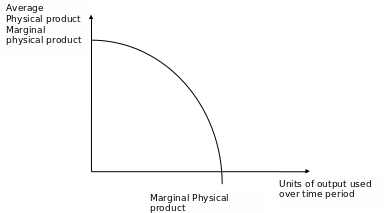
The law of diminishing marginal returns states that when a firm mixes variable and fixed inputs, the marginal productivity of the variable input decreases with increases in use. It is the point where marginal physical product curve starts sloping downwards towards x- axis and beyond it.
This is due to the fact that if more of the input is added to the production process, a maximum point is reached where any additional value of inputs will result in a decrease in total output. For example, in the farm activities, when more of a variable input, like fertilizer, is added holding other factor inputs constant, the output level is increased up to a point where any additional fertilizer application will result into a negative output levels (Answers to end of chapter questions 2010).
Decreasing economies of scale
Economies of scale refer to cost benefits accruing to a firm when increasing its scale of operations over a long run period. Diseconomies of scale occur when increasing the level of output results into a higher average cost. Therefore, a firm with high level of fixed cost should increase its output in order to lower its long run average cost curve.
Diseconomies may be caused by lack of cooperation, control and coordination due to the large number of employees in an organization which causes communication breakdown, thus lowering productivity and quality of output from employees. Example is that the size of an organization increases due to increase in the number of employees.

References
“Answers to end of chapter questions,” Monopolistic Competition and Oligopoly, 2010. Web.
Jeff B 2001, Microeconomic reform in Australia – An introduction. Web.
Market supply in the long run. Web.
Productivity Commission 1999, Microeconomic Reform and Australian Productivity: Exploring the Links, Commission research paper, Canberra. Web.
The basics of monopolies. Web.